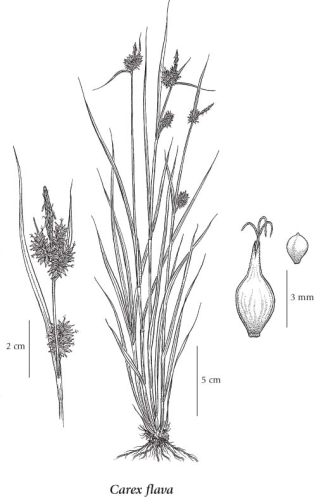Carex flava L.
yellow sedge (large yellow sedge)
Cyperaceae (Sedge family)
Introduction to Vascular Plants
yellow sedge (large yellow sedge)
Cyperaceae (Sedge family)
Introduction to Vascular Plants
Species Information click to expand contents
General:
Perennial, densely tufted herb from fibrous roots; stems 10-80 cm tall, longer than the leaves.
Leaves:
Sheaths straw-coloured to greenish; blades 4 to 8 per stem, flat or channelled below, borne on the lower 1/2 of the stem, 2-5 mm wide, the lower ones reduced or lacking.
Flowers:
Spikes 3 to 7, the terminal one unstalked or short-stalked, linear, 5-20 mm long, with male flowers (rarely some female flowers), the lower spikes 2 to 5, erect, cylindrical, 5-19 mm long, many-flowered, with female flowers (sometimes with male flowers at the tips), long-stalked, the stalks 5-20 mm long; bracts subtending the female spikes conspicuous, leaflike, 3-8 cm long, much exceeding the inflorescence, the sheaths 2-20 mm long, the upper bracts shorter.
Fruits:
Perigynia spreading to reflexed, egg-shaped, 4.2-6.5 mm long, 1.2-2 mm wide, yellowish-green to green, smooth, prominently nerved, 2-ribbed, the beaks about as long as the bodies of the perigynia, bidentate, finely toothed on the margins, reddish-tinged at the tips; female scales egg-shaped, pointed, shortly awned at the tips, narrower and much shorter than the perigynia, reddish to brownish, with greenish midribs and translucent margins; stigmas 3; achenes 3-angled, smooth, 1.2-1.5 mm long.
Illustration click to expand contents

If more than one illustration is available for a species (e.g., separate illustrations were provided for two subspecies) then links to the separate images will be provided below. Note that individual subspecies or varietal illustrations are not always available.
Illustration Source: The Illustrated Flora of British Columbia
Ecology click to expand contents
Ecological Framework for Carex flava
The table below shows the species-specific information calculated from
original data (BEC database) provided by the BC Ministry of Forests and Range.
(Updated August, 2013)
The table below shows the species-specific information calculated from
original data (BEC database) provided by the BC Ministry of Forests and Range.
(Updated August, 2013)
| Site Information |
Value / Class |
||
|
Avg |
Min |
Max |
|
| Elevation
(metres) |
1015 | 20 | 1890 |
| Slope
Gradient (%) |
2 | 0 | 35 |
|
Aspect (degrees) |
71 | 10 | 340 |
| Soil
Moisture Regime (SMR) [0 - very xeric; 4 - mesic; 8 - hydric] |
6 | 3 | 8 |
| Modal
Nutrient Regime
Class |
D | ||
| #
of field plots species was recorded in: |
33 | ||
| Modal
BEC Zone Class |
MS | ||
|
All BEC Zones (# of stations/zone) species was recorded in |
BWBS(1), CWH(5), ESSF(5), ICH(6), IDF(3), MS(10), SBS(1) | ||
|
Source:
Klinkenberg 2013
|
|||
Habitat and Range click to expand contents
Bogs, swamps, shorelines and wet, sandy sites in the lowland and montane zones; frequent in S BC, rare northward, absent on the Queen Charlotte Islands; disjunct circumpolar, N to AK and YT, E to NF and S to NH, NJ, PA, VA, OH, IN, WI, MN, CO, ID and WA; Iceland, Europe.
Status Information click to expand contents
Synonyms click to expand contents
Synonyms and Alternate Names:
Carex flava var. fertilis Peck
Carex flava var. gaspensis Fern.
Carex flava var. graminis Bailey
Carex flava var. laxior (Knkenth.) Gleason
Carex flava var. lepidocarpa (Tausch) Gord.
Carex flava var. nelmesiana (Raymond) B. Boivin
Carex flava var. rectirostra Gaudin
Carex lepidocarpa Tausch
Carex nevadensis subsp. flavella (Krecz.) Janchen